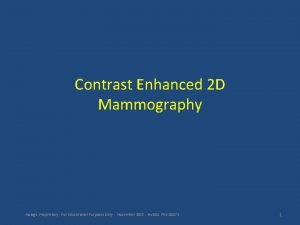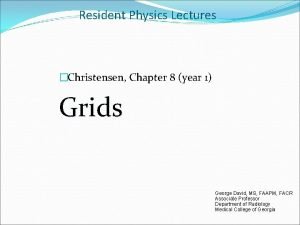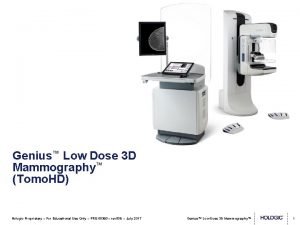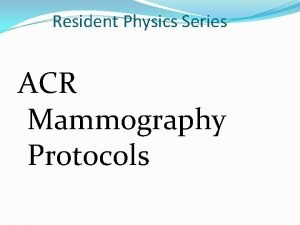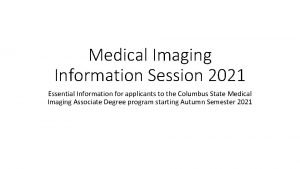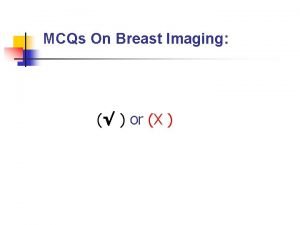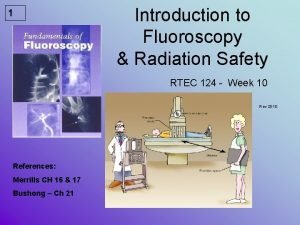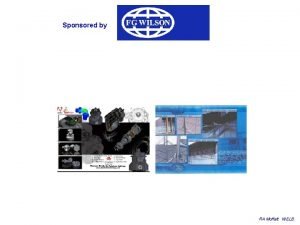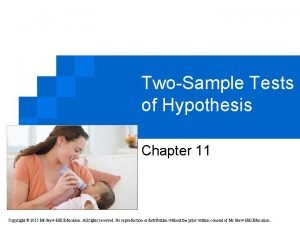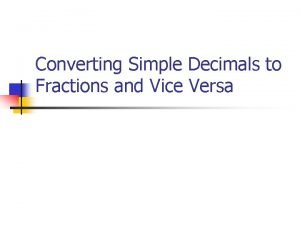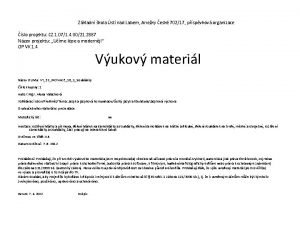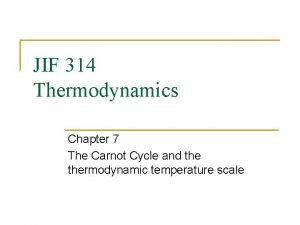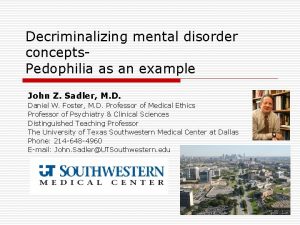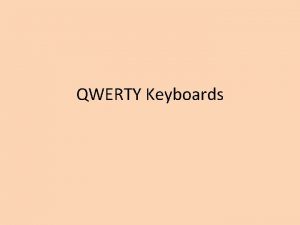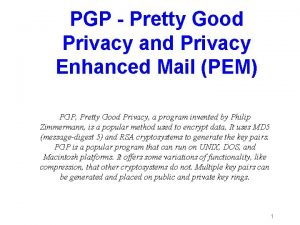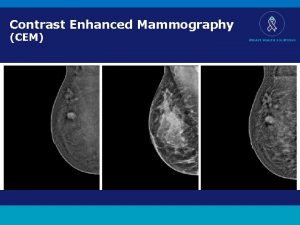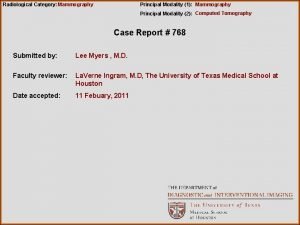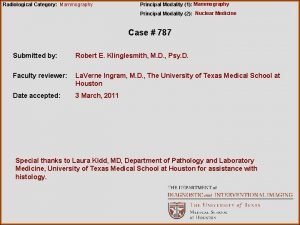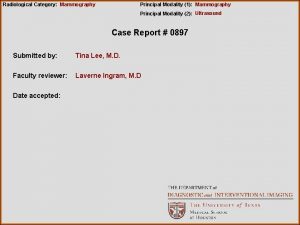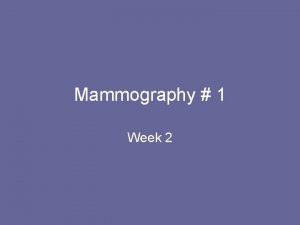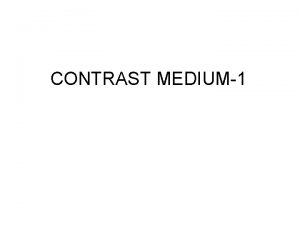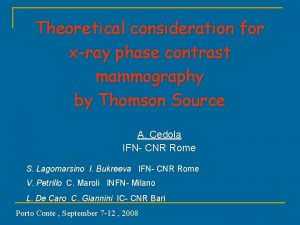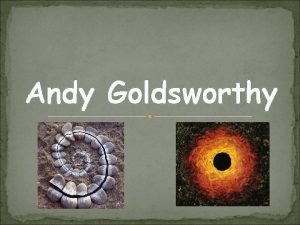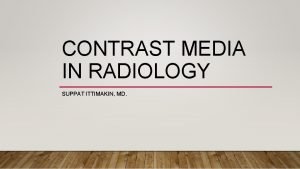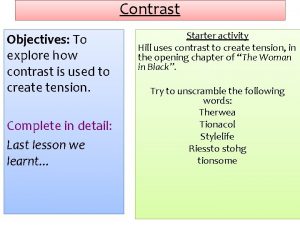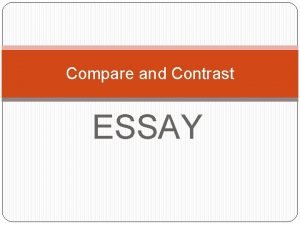Contrast Enhanced Mammography Andy Smith Ph D Vice


















































- Slides: 50

Contrast Enhanced Mammography Andy Smith, Ph. D. Vice President, Image Research Hologic Confidential, 2017. Do not distribute. 1

Learning Objectives on Contrast Mammo • What it is • How it works • When to use it • Its benefits • Comparison to alternate modalities • Required hardware • Implementation challenges • Reimbursement considerations Hologic Confidential, 2017. Do not distribute. 2

Terminology Several names mean the same thing: – CEDM is Contrast Enhanced Digital Mammography – CEM is Contrast Enhanced Mammography – CESM is Contrast Enhanced Spectral Mammography – CE 2 D is Contrast Enhanced 2 D Mammography They are all 2 D contrast images (at this time) Hologic Proprietary and Confidential

Contrast Enhanced Imaging Detection of increased formation of blood vessels (angiogenesis) associated with tumor development Growing Tumor Source: Time Magazine, May 1998 Cancer cells migrate to other parts of the body Hologic Proprietary and Confidential

Contrast Enhanced Imaging • Breast MRI – uses Gd contrast agent with MRI • CE 2 D – uses Iodine contrast agent with mammo • Same basic physiologic principle – Images lesions with higher neovascularity and extracellular leakage of contrast agent • Same basic advantages/disadvantages – High sensitivity for cancer detection – False positives: some benign lesions enhance • Both involve injection • Imaging not affected by breast density

CE 2 D Potential Clinical Applications • Alternative to Breast MRI – Evaluate difficult to interpret mammograms 1 – Monitor effectiveness of drug therapy 3 – Identify potential undetected malignancies 1 – High risk screening (not FDA approved) – Patients contraindicated for MRI 2 1 Lewin et al. Contrast Mammography Reveals Hard-to-Find Cancers. RSNA Press Release. 30 th September 2003. SP, Localio AR, Conant EF, Rosen M, Thomas KM, Schnall MD. Multimodality screening of high-risk women: a prospective cohort study. J Clin Oncol. 2009 Dec 20; 27(36): 6124 -8. doi: 10. 1200/JCO. 2009. 24. 4277. Epub 2009 Nov 2. 3 http: //www. acr. org/~/media/2 a 0 eb 28 eb 59041 e 2825179 afb 72 ef 624. pdf 2 Weinstein Hologic Proprietary and Confidential

FDA approved CE systems • GE Essential Seno. Bright – CE 2 D • Hologic Dimensions I-View – CE 2 D + Tomo Hologic Proprietary and Confidential

A Typical CE 2 D Procedure Hologic Proprietary and Confidential

1. Contrast Agent Administration • Standard non-ionized CT contrast agent – IV injection – 1. 5 cc/kg body weight – 3 cc/sec via Power Injector – Saline flush after injection – Need to assess for renal sufficiency • Breast is uncompressed during injection • Wait ~2 minutes post injection before imaging Hologic Proprietary and Confidential

2. Dual Energy 2 D Imaging • Two exposures are made in rapid sequence: 1. Low k. V (normal mammogram) 2. High k. V (~45 -49 k. V, Cu filter) • Subtraction gives a 2 D contrast image • Repeat as desired – Imaging window ends after ~6 minutes due to contrast redistribution Hologic Proprietary and Confidential

Dual-Energy Subtraction • You cannot see the contrast in high or low k. V images • But you can if we subtract the images: Subtraction = high k. V - low k. V Low k. V High k. V Subtraction • Only the low k. V and subtraction images are stored Hologic Proprietary and Confidential

CE 2 D – Dual Energy 2 D • Low k. V, High k. V images acquired for each view • Views can be any order Ipsilateral Breast MLO CC H E n e rg y Contralateral Breast CC H MLO H H L L ~120 s ~180 s ~240 s ~300 s inject 0 s ~480 s Hologic Proprietary and Confidential

A Typical CE 2 D Combo Procedure Hologic Proprietary and Confidential

CE 2 D + Tomosynthesis Acquisition • The CE 2 D images can also be part of a combo acquisition, giving 3 -D tomosynthesis information • Provides co-registered physiological and morphological data • If you can correlate the CE 2 D lesion to a tomo lesion, can perform tomo biopsy Hologic Proprietary and Confidential

1. Contrast Agent Administration • Identical steps as in the CE 2 D procedure Hologic Proprietary and Confidential

2. Dual Energy 2 D Combo Imaging • Three exposures are made in rapid sequence: 1. Low k. V tomosynthesis scan 2. Low k. V (normal mammogram) 3. High k. V (~45 -49 k. V, Cu filter) • Subtraction gives a 2 D contrast image • Repeat as desired – Imaging window ends after ~6 minutes due to contrast redistribution Hologic Proprietary and Confidential

Combo CE 2 D – Dual Energy 2 D with Tomosynthesis • Tomo, Low k. V, High k. V images acquired for each view • Views can be any order Hologic Proprietary and Confidential

Patient Work Flow From Palmieri et al, 2016 ARRS Annual Meeting Hologic Proprietary and Confidential

Example Images Courtesy of Andrea Woodroof, Kentucky Breast Care Hologic Proprietary and Confidential

Case 1 Hologic Proprietary and Confidential

CE 2 D for Discordant Findings • 52 y. o. female, presented for screening • 0. 8 cm spiculated mass in the left axillary tail noted on both 2 D and 3 D • Focal area of possible distortion noted on 3 D Hologic Proprietary and Confidential

CE 2 D for Discordant Findings Hologic Proprietary and Confidential

CE 2 D for Discordant Findings • Area of distortion couldn’t definitively be correlated on ultrasound for US biopsy Hologic Proprietary and Confidential

CE 2 D for Discordant Findings Hologic Proprietary and Confidential

CE 2 D for Discordant Findings • Area of distortion couldn’t definitively be correlated on ultrasound for US biopsy • The enhancing mass on CE 2 D was correlated with the tomo distortion • Tomo-guided biopsy ensued Hologic Proprietary and Confidential

CE 2 D for Discordant Findings Hologic Proprietary and Confidential

Case 2 Hologic Proprietary and Confidential

CE 2 D for MRI Contraindications • • Patients with pacemakers Body habitus Claustrophobia Lack of insurance or deductible cost issues Hologic Proprietary and Confidential

CE 2 D for MRI Contraindications • 50 y. o. female with pacemaker and 6 -month history of irritation underlying skin of left breast • Patient assumed irritation due to the pacemaker, but it didn’t resolve Hologic Proprietary and Confidential

CE 2 D for MRI Contraindications Hologic Proprietary and Confidential

CE 2 D for MRI Contraindications Imaging demonstrated 4 cm spiculated mass US biopsy Pathology: Invasive ductal carcinoma Patient referred to oncology and neoadjuvant chemotherapy • Pre and post-treatment MRI not possible; PET declined by insurance • CE 2 D performed • • Hologic Proprietary and Confidential

CE 2 D for MRI Contraindications Hologic Proprietary and Confidential

CE 2 D for MRI Contraindications • Prior to therapy, 3. 4 cm mass showed strong enhancement • 3 month interval showed decrease of size of mass to 1. 7 cm. Hologic Proprietary and Confidential

CE 2 D for MRI Contraindications Hologic Proprietary and Confidential

Case 3 Hologic Proprietary and Confidential

Evaluating Extent of Disease in Dense Breasts and Neoadjuvant Chemotherapy Response • • 49 y. o. female with palpable mass 2 D/Tomo imaging revealed spiculated mass Pathology IDC Extent of disease difficult to measure with either 2 D or Tomo due to dense parenchymal tissue Hologic Proprietary and Confidential

Evaluating Extent of Disease in Dense Breasts and Neoadjuvant Chemotherapy Response Hologic Proprietary and Confidential

Evaluating Extent of Disease in Dense Breasts and Neoadjuvant Chemotherapy Response • Prior to initiation of neoadjuvant chemotherapy, CE 2 D was performed • 1. 5 x 1. 3 cm enhancing spiculated mass Hologic Proprietary and Confidential

Evaluating Extent of Disease in Dense Breasts and Neoadjuvant Chemotherapy Response Hologic Proprietary and Confidential

Evaluating Extent of Disease in Dense Breasts and Neoadjuvant Chemotherapy Response • Prior to initiation of neoadjuvant chemotherapy, CE 2 D was performed • 1. 5 x 1. 3 cm enhancing spiculated mass • CE 2 D image after 3 months demonstrates partial response to chemotherapy Hologic Proprietary and Confidential

Evaluating Extent of Disease in Dense Breasts and Neoadjuvant Chemotherapy Response Hologic Proprietary and Confidential

Clinical Performance Hologic Proprietary and Confidential

Clinical Performance Hologic Proprietary and Confidential

Diagnostic Clinical Performance • CE 2 D higher sensitivity than 2 D or tomo • CE 2 D and b. MRI show comparable performance • CE 2 D and b. RMI have comparable accuracy in tumor sizing • Patients prefer CE 2 D over b. MRI 1. 2. 3. 4. 5. Fallenberg E, Dromain C, Diekmann F, et al. Contrast-enhanced spectral mammography versus MRI: Initial results in the detection of breast cancer and assessment of tumour size, Eur. Radiol. 24 (1) (2013) 256– 264. Chou C, Lewin J, Chiang C et al. "Clinical Evaluation of Contrast-Enhanced Digital Mammography and Contrast Enhanced Tomosynthesis-Comparison to Contrast. Enhanced Breast MRI" Eur J Radiol. 2015 Dec; 84(12): 2501 -8. [Epub 2015 Oct 1]. ochelson M, Dershaw D, Sung J, et al. , Bilateral contrast-enhanced dual-energy digital mammography: feasibility and comparison with conventional digital mammography and MR imaging in women with known breast carcinoma, Radiology 266 (3) (2013) 743– 751. Lobbes MB, Lalji UC, Nelemans PJ, et al. The quality of tumor size assessment by contrast-enhanced spectral mammography and the benefit of additional breast MRI. J Cancer. 2015; 6(2): 144 -150. Hobbes M, Taylor D, Buzynski S et al. “Contrast-enhanced spectral mammography (CESM) and contrast enhanced MRI (CEMRI): Patient preference and tolerance” J Med Imaging Radiat Oncol. 2015 Jun; 59(3): 300 -5. [Epub 2015 Apr 21]. Hologic Proprietary and Confidential

Comparison to MRI • Advantages of CE 2 D – Lower cost procedure – Faster procedure (7 -10 min vs 30 -60 min for b. MRI) – Fast readings – Good imaging of microcalcifications (low energy image) • Disadvantages of CE 2 D – Don’t get both breasts at same time – Hard to get time-activity information – Involves radiation, but FFDM usually ordered with b. MRI – Iodine contrast agent adverse reactions Hologic Proprietary and Confidential

Required Hardware • Mainly a software upgrade • Also includes additional x-ray filter (copper) • May require detector upgrade for older systems Hologic Proprietary and Confidential

Implementation Considerations Power injector Who will place the IV line and perform injection? Crash cart Review risk mitigation policies regarding contrast agents • Menstruation cycle. Same as MRI. 7 -14 days after last period • Tube heating. Need to wait ~10 minutes after procedure • • Hologic Proprietary and Confidential

Reimbursement Hologic Proprietary and Confidential

Summary • Potential Clinical Applications – Viable alternative to MRI – Evaluating patients contraindicated for MRI – Monitoring effectiveness of drug therapy – Identify potential undetected malignancies Hologic Proprietary and Confidential

Thank you! Email: andrew. smith@hologic. com Hologic Confidential, 2017. Do not distribute. 50
 Hologic contrast enhanced mammography
Hologic contrast enhanced mammography Jerry allison
Jerry allison Mammography qa
Mammography qa Upside down focused grid
Upside down focused grid Standard screening tomohd
Standard screening tomohd Mqsa requirements for mammography checklist
Mqsa requirements for mammography checklist Ohiohealth berger hospital mammography circleville
Ohiohealth berger hospital mammography circleville Mammography
Mammography Components of mammography machine
Components of mammography machine Xbreast
Xbreast Self breast exam
Self breast exam Compare and contrast, karl marx and adam smith venn diagram
Compare and contrast, karl marx and adam smith venn diagram Double contrast vs single contrast
Double contrast vs single contrast Malaki ang kinita ng mga pilipino sa monopolyo sa tabako
Malaki ang kinita ng mga pilipino sa monopolyo sa tabako Barry goldwater communism
Barry goldwater communism Senior regional vice president
Senior regional vice president Senior regional vice president
Senior regional vice president Age of vice president
Age of vice president The inherent vice of capitalism
The inherent vice of capitalism Lee tait
Lee tait Ffa advisor owl
Ffa advisor owl Mary jo fitzpatrick is the vice president
Mary jo fitzpatrick is the vice president Changing decimals to fractions and vice versa
Changing decimals to fractions and vice versa Ffa officers and their duties
Ffa officers and their duties Vice president training
Vice president training Více hlásek než písmen
Více hlásek než písmen Vice president duties in a club
Vice president duties in a club Vice president training
Vice president training Senior regional vice president
Senior regional vice president Bod zvratu pro více produktů
Bod zvratu pro více produktů Microsoft fargo campus
Microsoft fargo campus Quais eram os vice-reinos da américa espanhola
Quais eram os vice-reinos da américa espanhola Ducks unlimited president
Ducks unlimited president Party is such sweet sorrow vice game
Party is such sweet sorrow vice game Vice president membership
Vice president membership What do vice presidents do in clubs
What do vice presidents do in clubs Surenos colors
Surenos colors Neil campbell qc
Neil campbell qc Senior regional vice president
Senior regional vice president Conversion of work into heat and vice versa
Conversion of work into heat and vice versa Xxx
Xxx Vice-laden
Vice-laden Tanuvas vice chancellor
Tanuvas vice chancellor Enhanced platform awareness
Enhanced platform awareness Enhanced healthcare solutions
Enhanced healthcare solutions Alice enhanced lockdown
Alice enhanced lockdown Keyboard features
Keyboard features Privacy-enhanced mail
Privacy-enhanced mail Disturbed personal identity
Disturbed personal identity Contoh erd generalisasi
Contoh erd generalisasi Enhanced greenhouse effect
Enhanced greenhouse effect
